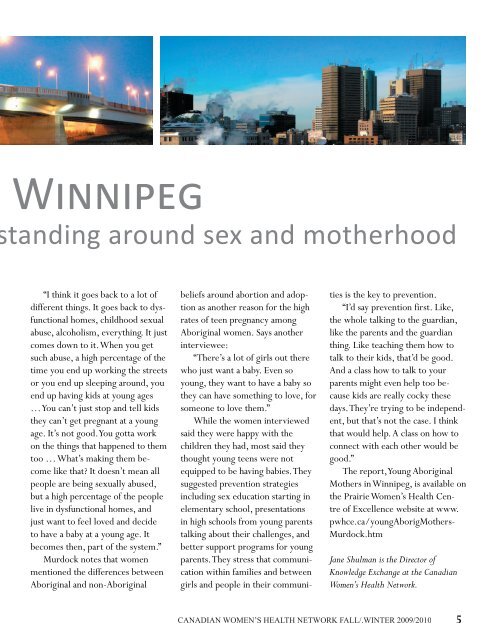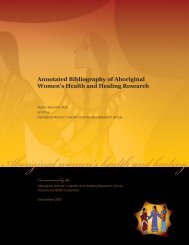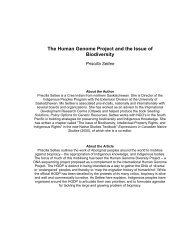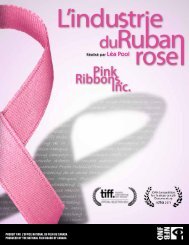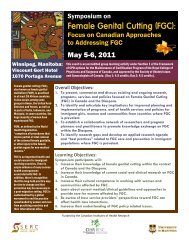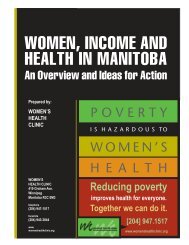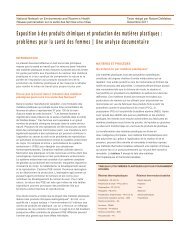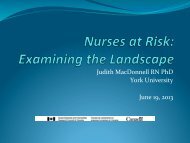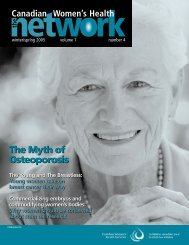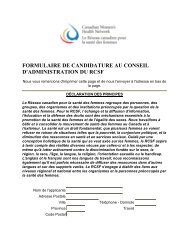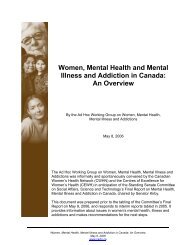Network 12-1.pdf - Canadian Women's Health Network
Network 12-1.pdf - Canadian Women's Health Network
Network 12-1.pdf - Canadian Women's Health Network
Create successful ePaper yourself
Turn your PDF publications into a flip-book with our unique Google optimized e-Paper software.
W<br />
tanding around sex and motherhood<br />
“I think it goes back to a lot of<br />
different things. It goes back to dysfunctional<br />
homes, childhood sexual<br />
abuse, alcoholism, everything. It just<br />
comes down to it. When you get<br />
such abuse, a high percentage of the<br />
time you end up working the streets<br />
or you end up sleeping around, you<br />
end up having kids at young ages<br />
… You can’t just stop and tell kids<br />
they can’t get pregnant at a young<br />
age. It’s not good. You gotta work<br />
on the things that happened to them<br />
too … What’s making them become<br />
like that? It doesn’t mean all<br />
people are being sexually abused,<br />
but a high percentage of the people<br />
live in dysfunctional homes, and<br />
just want to feel loved and decide<br />
to have a baby at a young age. It<br />
becomes then, part of the system.”<br />
Murdock notes that women<br />
mentioned the differences between<br />
Aboriginal and non-Aboriginal<br />
beliefs around abortion and adoption<br />
as another reason for the high<br />
rates of teen pregnancy among<br />
Aboriginal women. Says another<br />
interviewee:<br />
“There’s a lot of girls out there<br />
who just want a baby. Even so<br />
young, they want to have a baby so<br />
they can have something to love, for<br />
someone to love them.”<br />
While the women interviewed<br />
said they were happy with the<br />
children they had, most said they<br />
thought young teens were not<br />
equipped to be having babies. They<br />
suggested prevention strategies<br />
including sex education starting in<br />
elementary school, presentations<br />
in high schools from young parents<br />
talking about their challenges, and<br />
better support programs for young<br />
parents. They stress that communication<br />
within families and between<br />
girls and people in their communi-<br />
ties is the key to prevention.<br />
“I’d say prevention first. Like,<br />
the whole talking to the guardian,<br />
like the parents and the guardian<br />
thing. Like teaching them how to<br />
talk to their kids, that’d be good.<br />
And a class how to talk to your<br />
parents might even help too because<br />
kids are really cocky these<br />
days. They’re trying to be independent,<br />
but that’s not the case. I think<br />
that would help. A class on how to<br />
connect with each other would be<br />
good.”<br />
The report, Young Aboriginal<br />
Mothers in Winnipeg, is available on<br />
the Prairie Women’s <strong>Health</strong> Centre<br />
of Excellence website at www.<br />
pwhce.ca/youngAborigMothers-<br />
Murdock.htm<br />
Jane Shulman is the Director of<br />
Knowledge Exchange at the <strong>Canadian</strong><br />
Women’s <strong>Health</strong> <strong>Network</strong>.<br />
CANADIAN WOMEN’S HEALTH NETWORK FALL/.WINTER 2009/2010 5


